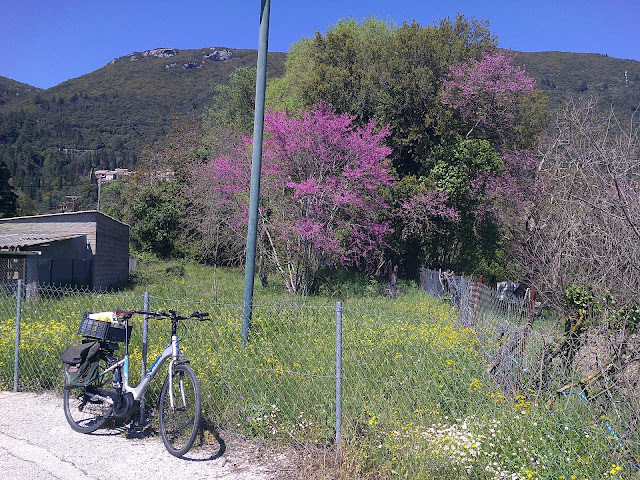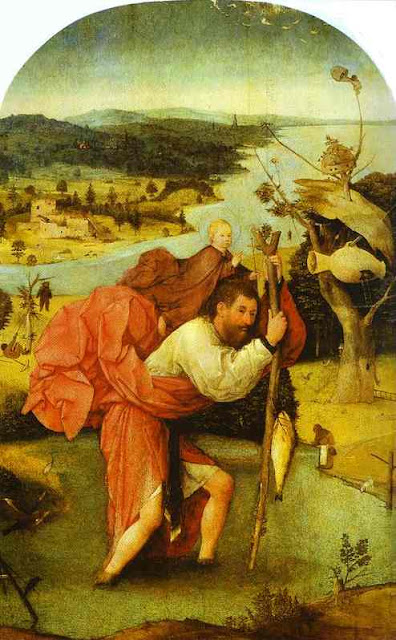 |
| Looking over the Sea of Kerkyra towards Epirus in Mother Greece. The small island is Vido |
Having been away – because of travel restrictions - since last December there have been more than a few gardening jobs to do. A spreading squash has climbed the fence into our garden from Vasilikki’s. Its broad palmate leaves and hairy stems, hanging by tendrils, spread to the ground. Most of its yellow flowers are male.

On a whim I decide to have a go at doing work that’s better done by bees. I pull up a chair to get a closer view of the vine, looking to take the stamen of a male flower and touch it to the stigma of a female. I’d found find several squashes forming – kolokithakia Κολοκυθάκια – but could find no more female flowers on which to experiment. There’s a crack of thunder. The sky goes grey, rain descends, and the washing I’ve hung out gets a further rinse. As the days pass the lower squash has grown to a satisfied potentate, nestling among its decaying leaves, yellowing, a smaller satrap hanging six feet above. We on high ground only heard of the consequences of several days of rain in the south of the island.
 |
| Flooding in Moraitika |
Our Bougainvillea, plant of a thousand hybrids even within a square mile, flourishes as it hasn’t for years, in some cases surging through the planks of the balcony. Work above and below with the loppers sorts that, with the help of a hammer and chisel where a stem has hardened, wedged itself between decking.
The Wisteria, about 12 years old, had invaded our already enfeebled orange tree, the wooden balcony, the down pipe of the roof gutter, reaching into the upper branches of our neighbour's walnut tree. I tame it with an hour's discipline of shears, long reach loppers and secateurs, until it hangs meekly along the metal railings of our side balcony.
One of Amy’s presents for her mum’s 70th birthday included a string of solar lights. Lin’s wound them along the railings amid the wisteria and with many hours of sunshine they shine out from dusk to dawn like a distant city street The trumpet vine leans nonchalantly over the front of the balcony, less invasive than last year but full of flowers. I’ve cut back the top growth of the lemon tree in front of the balcony. For its safety, I’ve applied more of the anti-scale insect spray used last October and earlier. These insects seem, at last, to have given up, after blighting our citrus trees. Can this infestation really be over? There are many lemons on the larger tree, but none on the smaller. Our blood orange tree, once so fecund, hasn’t fruited for five years. Though still leaved, its periphery branches end in dried and blackened twigs. In the lower garden Lin’s cut back ‘what needed it’, including Yucca tops. She’s combed out dead growth, potted up cuttings, moved many of our plant pots on the steps and swept up accumulations of fallen leaves and petals, and watered widely. Things are, and therefore life, is tidier. Dimitri, a neighbour, has strimmed the path that goes below our house from Democracy Street down to ‘our’ bus stop on National Opposition Street.
Above us from before dawn well into the night the short holiday harvest planes grumble to and fro above the mountain ridge behind us, often half full, we’re told, of travellers in masks who, like us, have completed or booked Covid immunity tests, shown their vaccine certificate and other proofs of immunity, filed their PLFs and prepared for self-isolation on arrival.
We are almost always without a car. Hirers may have none available, or they're too expensive. We rely on the daily bus at 7.45am and early afternoon back from the city. There’s my bicycles. But for the local bakery – OK for wine and bread – our grocery is 8 kilometres away. A grocer in a truck visits us Tuesday and Saturday, crying his wares as he drives back and forth through ours and the lower roads.
I'm beginning to find the uphill pedal to the village, with kilos of shopping in the rear basket, and especially the ascent by the last four hairpin bends, more of an ordeal than an achievement, especially in the heat of August. On impulse I did what I had told myself I wouldn’t do. I cycled on the bike I'd bought from them 10 years ago, to Rolando’s and Elena’s shop opposite the hospital in Kontokali, and bought an eBike with a Bosch crank-driven motor.
Other electric bicycles have a battery drive on the hub of the wheel. My drive sits between the pedals - Active Line Plus offering increasing levels of power to support my pedalling with increments of back-up power that proceed from normal cycling without the battery rising to 40% (Eco) to 100% (Tour), to 180% (Sport) to 270% (Turbo) support -
... all shown on a little screen beside an up-down button on the handlebars controlled by my left hand index finger. That's helped by seven derailleur gears on my rear chain drive controlled by a right hand twist grip - allowing me to decide how hard I want to work and how much I want to delegate to my battery, while still pedalling. Stop pedalling or reach a speed over 25kph and the edrive cuts out. Friends noting my occasional grumbles about the effort of cycling up the hills into Ano Korakiana had said “just get an e-bike, Simon”
“Spawn of the devil!” I retorted “They erode the moral compass of cycling – no pain no gain and vice versa.”
Now my cavilling is dismissed. I love this machine.
 |
| My e-bike on a hill looking south across the island of Corfu |
Naturally disinclined to effort for its own sake, I rejoice in journeys back from Kaizani’s at Tzavros, with a good 10 kilos of shopping secured by bungies in a plastic crate cable-tied to my rear rack – a journey of over an hour now less than 40 minutes with a triumphant ascent into Democracy Street in lowest gear and ‘turbo’. There’s also a ‘walk’ function that, without having to be mounted and pedalling, helps me wheel the ebike up the 13 steps from home to the road. I’ve now cycled up the 29 hairpin ascent to Sokraki – the village on the watershed above us. I have done this twice on my ordinary bike but it’s a route that now tests my 79 years. I’ve been into the city – 22 miles return journey, made several journeys to Doukades using the main road, country roads and gravel tracks. I’ve cycled effortlessly home at night from eating with friends a mile below the village. For that I’ve strolled beside Lin on a gravel track, then, arriving at the metalled road, headed off by unlit hilly roads while Lin walks the stepped short-cut to Democracy Street. I’ve cycled from Sokraki to Trompeta in gentle drizzle then down through the woods to Doukades and home via Skripero – the dial shows I’ve already covered over 420 kilometres. In mid November I cycled to the top of Mount Pantokrator - a round journey of 54 kilometres nursing the battery by pedalling most of the ascent on 'eco'.
 |
| Some years ago we had a family picnic close to the top of Mount Pantokrator |
Route: Up the steep winding ascent to Sokraki; take the short bypass round the village centre down to meet the steep descent to the river valley, then up a hundred metres to Zygos, up up to Sgourades, on the Spartillas-Acharavi road, along a kilometer of level; then the turn up to Strinilas - the longest haul part of the ascent; from Strinilas, tavernas closed for winter and latest Covid restrictions, down briefly to the right turn up again to the gently rolling road to the foot of the steep mound that leads to the summit of the mountain, up which I walked, as, even on 'turbo', the kilometre of mostly concrete road is too steep for me and my ebike. I trudge - assisted by the bike's 'walk' function. Lingering on the roof of the island gazing round the compass - the peaks of Albania and Epirus across the Corfu Channel, the Adriatic stretching beyond the north coast settlements - Roda, Acharavi, and inland Old Perithia and south to two little peaks of the old fort and the city and much in between, I watch the cats and chat to Sotiris the gardener and a candle lit in the monastery church, much silence but for the wind in the aerials, then down down down down again to Sgourades and then return via a different road, to Spartilas with two clicks left on the five click battery. I stop at a taverna in Spartillas for a diplo skerto and cheese and ham toastie, my vaccination covid certificate sought. Can I make it home on what's left in the battery? I freewheel down the long descent, nearly to the sea at Pyrgi, then up again through Agios Markos and another mile into Democracy Street, Ano Korakiana. I did this journey first by traditional bicycle in 2012.
I was back early afternoon, having the summit almost to myself via almost car less roads, proving to myself there are few places on the island I can't reach and return. Our friend Jenny, who has the same bike, says that relying on the lowest charge I should be able to cycle 60 kilometres. I've now satisfied myself of that, having power to spare on returning from Pantokrator. I’m almost back to the moral compass I’ve abandoned. 50 kilometres from Ano Korakiana can take me almost anywhere on this beautiful island. I could if concerned about remaining power ask a friendly taverna at the end of an outward journey to plug in my charger while I have a meal.
A folding bicycle invented by Andrew Ritchie over 30 years ago called a Brompton is the best product in a niche market. It’s not just a bike that can be taken apart easily. It folds in less than 30 seconds into a 12 kilo portable machine that can be carried on cars and public transport. I use the Brompton with public transport; best for negotiating traffic congested streets and the public spaces where I can mingle with walkers and other cyclists.
 |
| Awaiting the morning bus from the village into town at 07.45 |
I have owned several of these since the early 1990s. In February 2007 I was using a Brompton folding bike to travel by bike, rail and ferry with my friend John Richfield from the UK to Corfu via Paris and Venice to buy our home in Ano Korakiana.
 |
| Just off the ferry from Venice in 2010 |
We returned the same route.
 |
| On Via Garibaldi - the only filled-in canal in Venice, one of the few places anyone can cycle |
A few years later I shipped the same bike – a deep green T6 – from Birmingham to Corfu with furniture. Bought in June 2001, it’s quite old. I rode it downhill to the sea at Ipsos this August. It scared me - clunking and clicking like a straining bulkhead. The original Sachs hub was telling me noisily that it was shot. I phoned Mike at Phoenix Cycles in Battersea. The cost of a replacement wheel with a Sturmey hub gear, new sprockets, chain and chain tensioner was over £400, before adding 50% post-Brexit customs charges . It says something for the resale value of used second hand Bromptons that I was prepared to even think of spending what would be needed – over half its cost in 2001. The carriage was made suddenly reasonable when a friend offered to put wheel and trappings in her hand baggage from London and drop them off to me in the village. I was anxious – cack-handed as I am – about the reassembling work. Guided by Youtube tutorials on several tasks I secured the new sprockets to the new hub with a holding circlip, threaded a new gear cable and handlebar controller, replaced the derailleur for the other two gears. Adjusting the chain guide that switches the chain from one sprocket to another was tricky - for me. A small washer on which the guide swivels kept slipping from my fingers and hiding on the veranda floor. With help from Lin and my cyclist friend Gerard (who’d never seen a Brompton), the work was done. I reduced the new chain to 95 links using a chain breaker to force out the link rivet. I threaded it round the rear wheel sprockets, the chain tensioner jockeys and front chain-wheel, joining with a ‘quick link’ - an innovation that allows the chain to be joined and unjoined without the removal of a rivet. New to me. Repairs completed my folding bike performs better than new.
 |
| New hub gears, rear wheel, and chain tensioner - my old folding bicycle better than new |
The three Sturmey hub gears are superior to the Sachs they’ve replaced. Testing the restored Brompton I cycled slowly but steadily up to the small chapel of Agios Isadoras – five hairpin bends above the village.
 |
| Agios Isodoros on the winding road between Sokraki and Ano Korakiana |
So satisfying that the bottom of my 6 gears made that possible. I’ve since taken the folder into town to cycle happily through its maze of streets amid the walkers. I returned our hired car. Lifting the folded Brompton from its boot, I headed into the city centre for various errands - paperwork, especially for our Biometric Residency Cards interview with the Immigration department in the police station off Solari. Being Monday morning the town was near gridlocked, which made pedalling smoothly past a kilometre of fuming semi-stationary traffic queues, on Heptanisou and Lefkimmi Streets into Mitropoliti Methodiou and San Rocco Square, especially satisfying. To go home I caught the bus to Sokraki, Brompton in its luggage hold, and for €3 was driven, via Tzavros, Dassia, Ipsos and up the winding road to Spartillas, along to Sgourades – a wonderful bus route for seeing Corfu’s changes of scenery from city, seashores to forested mountains – then down to Zigos and up to Sokraki, 29 hair pin bends above Ano Korakiana.
 |
| The road from Sokraki to Ano Korakiana - 29 hairpin bends |
I sat outside Emily’s Taverna for snacks and conversation with their Polish waitress, Milena, and various customers, German and English. One couple from Manchester, arriving quietly in an electric car. They were living in Corfu - a man and his sister living in Karousades. As we chatted convivially about the comparative merits of marriage for men and women, the man – middle aged - told us he’d lost his wife to Covid. In the last two years I’ve known very few who’ve caught this much talked about condition – Lin suffering it for an uncomfortable fortnight in January 2020 before lay-people even had a name for SARS-CoV-2. On November 10th Lin and I decided depart from beloved
Greece. We flew back to England - Corfu Kapodistria, Athens Venizelos, London Heathrow and National Express coach back to Birmingham and Handsworth. Goodbye for a while. PLF and tests and 10 days self-isolation back in the UK except to buy food.





;_lithograph_by_George_de_la_Poer_Beresford.jpeg)






























